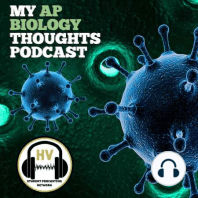11 min listen

Isotonic, Hypertonic, and Hypotonic Conditions
Isotonic, Hypertonic, and Hypotonic Conditions
ratings:
Length:
4 minutes
Released:
May 14, 2021
Format:
Podcast episode
Description
My AP Biology Thoughts Unit 2 Cell Structure and FunctionWelcome to My AP Biology Thoughts podcast, my name is Corrinna and I am your host for episode #60 called Unit 2 Cell Structure and Function: Isotonic, Hypotonic, and Hypertonic Conditions. Today we will be discussing the differences between these conditionsIsotonic, hypertonic, and hypotonic are all words to describe the conditions of a cell in relation to the amount of solute and water in them. An isotonic condition is when the concentration of water is the same inside and outside of the cell. This creates an equilibrium, so there will be no large movement of water in or out of the cell. However, an isotonic solution does allow for osmosis, but the rate of water moving in and out of the cell will always be the same. If a cell is in a hypertonic solution, water will flow out of the cell because there is a higher concentration of solute outside of the cell. This causes water to flow out of the cell because the concentration of water is lower outside of the cell, water will flow out of the cell to try to create an equilibrium. The word hypertonic comes from the Latin prefix hyper, which means above. In a hypertonic solution, a cell will shrink. If a cell is placed in a hypotonic solution, there is net flow of water into the cell because the solute concentration outside the cell is lower than inside the cell. Because of this, the water concentration inside the cell is lower than outside the cell, causing water to flow into the cell and the cell to expand. Plant and animal cells can thrive in different conditions because of their different characteristics. For example, red blood cells find isotonic solutions ideal because they maintain constant conditions. However, in plants, an isotonic solution will cause the pressure in the cells to decrease, and the plant will appear to wilt. In hypertonic solutions, neither plant nor animal cells thrive. In red blood cells, hypertonic solutions will cause the cells to shrivel and possibly die. In plant cells, hypertonic solutions will cause the plant to wilt because water leaves the cells. In order to avoid hypertonic situations, one can make sure that the plant or animal is properly hydrated. For animal cells, hypotonic solutions are harmful, and red blood cells may burst because the net flow of water is into the cell. However, hypotonic solutions are ideal for plant cells, because their cell walls don’t allow them to burst. In hypotonic conditions, plant cells become slightly enlarged but this is beneficial as it allows the plants to be more rigid and not wilt. Hypotonic solutions in plants can be caused by regular watering. Isotonic, hypertonic and hypotonic conditions are all very different, but they all indicate the health of the organism. The difference in reactions by plant and animal cells to these conditions show the different structures of plant and animal cells. Because plant cells have cell walls, they are able to thrive in hypotonic conditions whereas animal cells will likely die. However, these different structures enable their respective organisms to live, as we saw with plants and hypotonic solutions, which keep them from wilting. This shows that each type of cell has evolved to be able to best keep its organism alive. Thank you for listening to this episode of My AP Biology Thoughts. For more student-ran podcasts and digital content, make sure that you visit www.hvspn.com. See you next time!Music Credits:“Ice Flow” Kevin MacLeod (incompetech.com)
Released:
May 14, 2021
Format:
Podcast episode
Titles in the series (100)
Hardy-Weinberg Theory by My AP Biology Thoughts